Updated 3 weeks ago
Next-Gen Perspectives: What Gen Z and Young Millennials are Saying About Solar Energy and Sustainability Amidst Economic Challenges
Written by
Jamie Smith
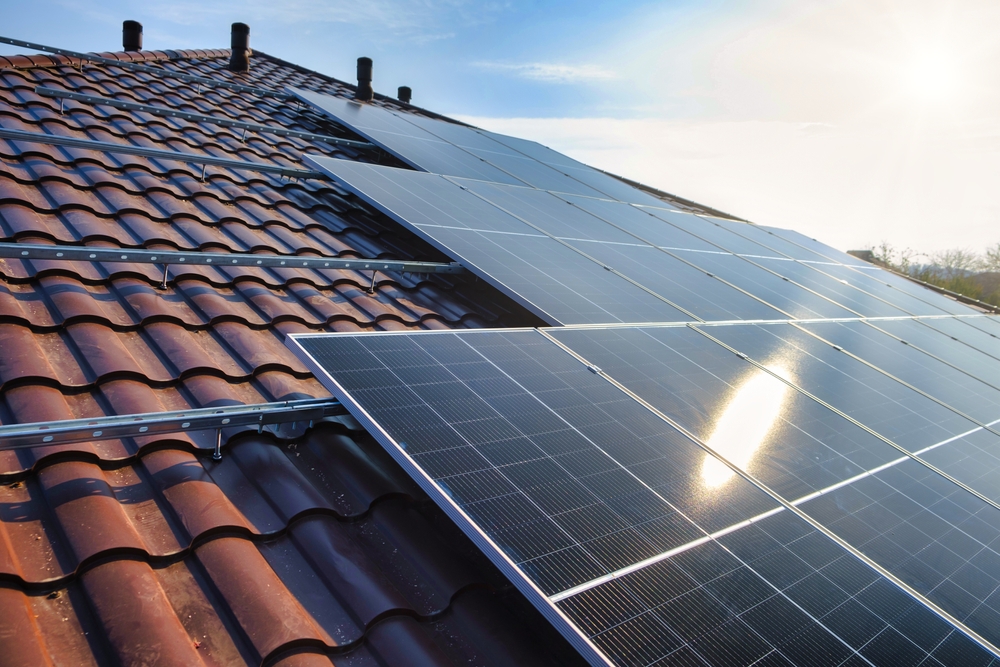
The U.S. has entered an era of economic uncertainty and struggles to stay afloat, and it’s no secret that younger generations are feeling the brunt of the effects. Along with financial challenges, environmental concerns and fears of climate change are prominent among Gen Zers and younger millennials.
Installing home solar panels is a way for individuals to not only make an eco-friendly decision but also save money on electricity bills. Solar seems like the best of both worlds for young adults, but is the upfront investment just out of reach for these generations?
Between September and August 2024, we surveyed 400 individuals aged 18 to 30 on sustainable practices, national concerns, solar, and more to dive into Gen Zers’ and young Millennials' minds and discover what this can mean for the solar industry’s future.
What we know about Gen Z and young millennials
As tensions rise around the uncertainty of the U.S. economy, Gen Zers and millennials are arguably on the frontlines, so much so that it’s beginning to impact their lifestyle choices:
Affording a house is becoming less feasible for a single person. According to Bankrate, Americans need an annual income of over $110,000 to afford a home. The average income for individuals aged 15 to 24 is a mere $54,930, while those aged 25 to 34 make an average of $85,780.
A recent Credit Karma study reveals that 'money dysmorphia,' a phenomenon that occurs when people (no matter their financial situation) feel insecure about their financial standing, is rampant among both generations.
According to MassMutual, nearly one in four millennials and Gen Zers cite finances as a reason for not having children. Furthermore, almost a third said today's social and political climate reduced their desire to have children.
Despite financial struggles, Gen Z and millennials are seen as more environmentally conscious than other generations. A study by Deloitte found that 62% of Gen Z and 59% of millennials reported feeling anxious or worried about climate change in 2024, and both generations actively took measures to lessen their environmental impact.
Our findings: What Gen Z and young millennials are saying
As Gen Zers and some millennials have begun to purchase homes and start families, there is uncertainty around the future of the solar industry. Despite environmental concerns, will the rising living costs make purchasing solar unattainable?
In SolarReviews’ 2024 Solar Industry Survey, installers reported that 30% of solar buyers are under the age of 40. We surveyed 400 individuals aged 18 to 30 (those considered to be reaching “solar buying age”) to learn more about how younger generations balance economic and environmental concerns. Here are our key findings.
1. Inflation and the rising cost of living have taken top priority for national concerns in 2024 among 18 to 30-year-olds
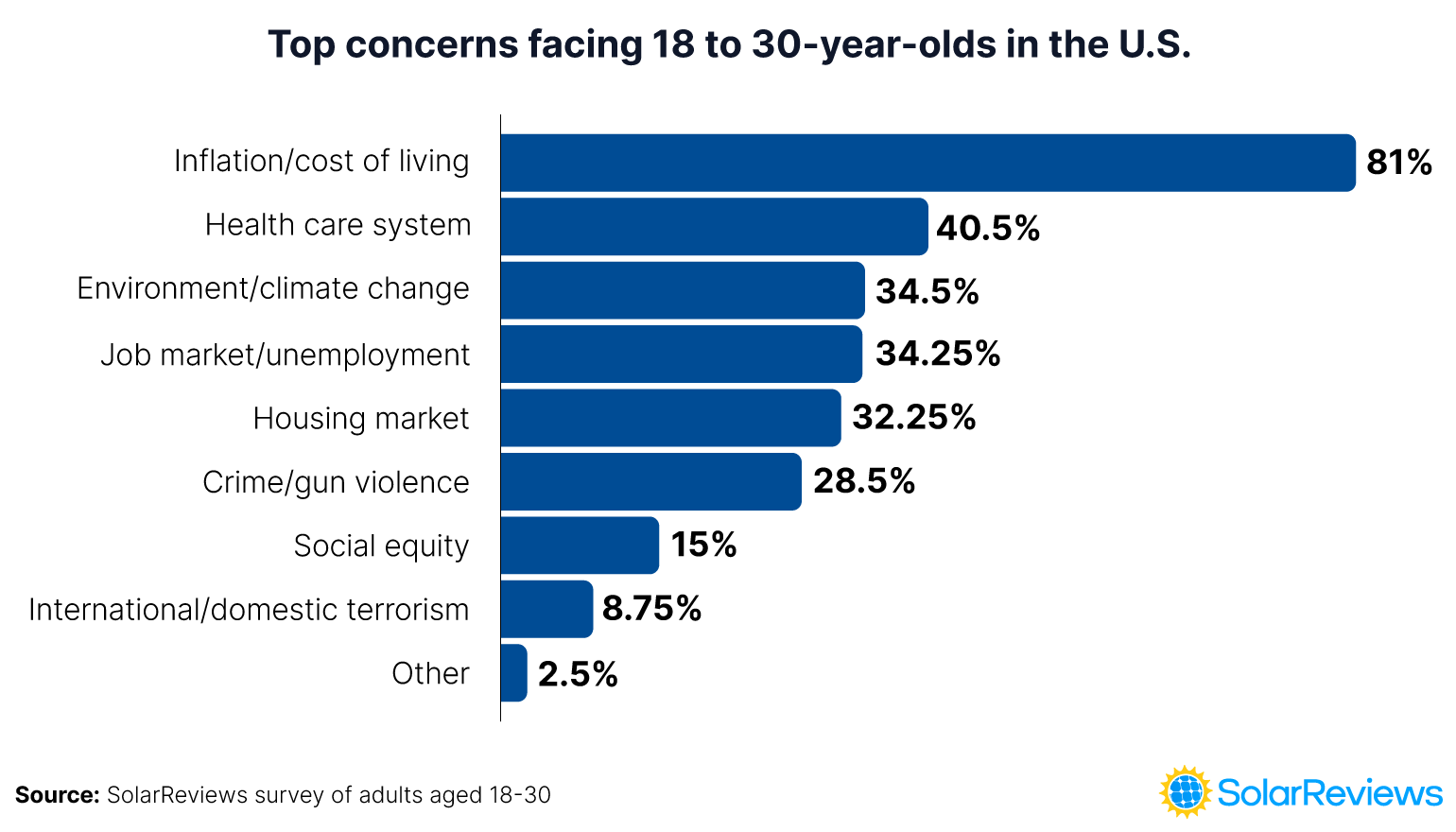
We asked our respondents to select the top three national issues that concern them the most. Not shockingly, 81% of respondents chose inflation and the rising cost of living as one of their top concerns. Behind inflation, the health care system (40.5%) and climate change (34.5%) were among the top three national concerns.
Basic necessities, such as groceries and monthly bills, have become a source of stress in the lives of many. 48% of our respondents reported paying over $100 each month on electricity alone, with the average electricity bill in America sitting around $150 per month.
With today’s average electricity prices, about 2 to 3% of annual income is going toward paying for electricity for those between the ages of 15 and 34. Let’s not forget that’s just one of many expenses Americans need to pay each month to stay afloat.
2. Environmental issues are at the forefront for respondents
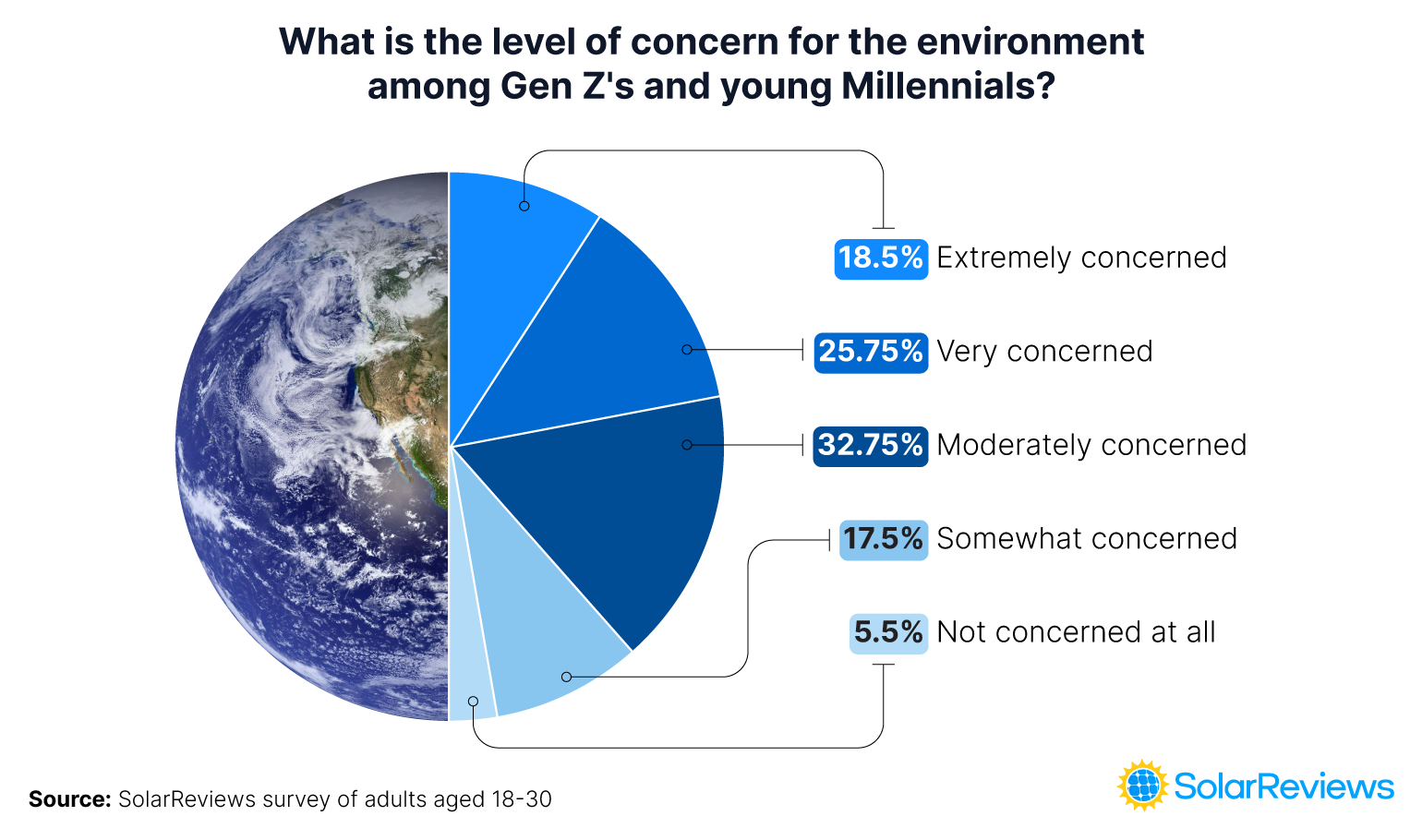
With inflation taking the top spot of national concerns, worries about the environment are not far behind. 94.5% of respondents expressed some level of concern for climate change and environmental issues, with over 44% reporting high levels of concern.
Anxiety revolving around environmental issues for Gen Zers and millennials has translated into taking action. In the last year, nearly 88% of respondents reported integrating sustainable and eco-friendly practices into their lifestyle at least once a month.
3. Gen Zers and early millennials are finding cost-effective solutions to fight climate change
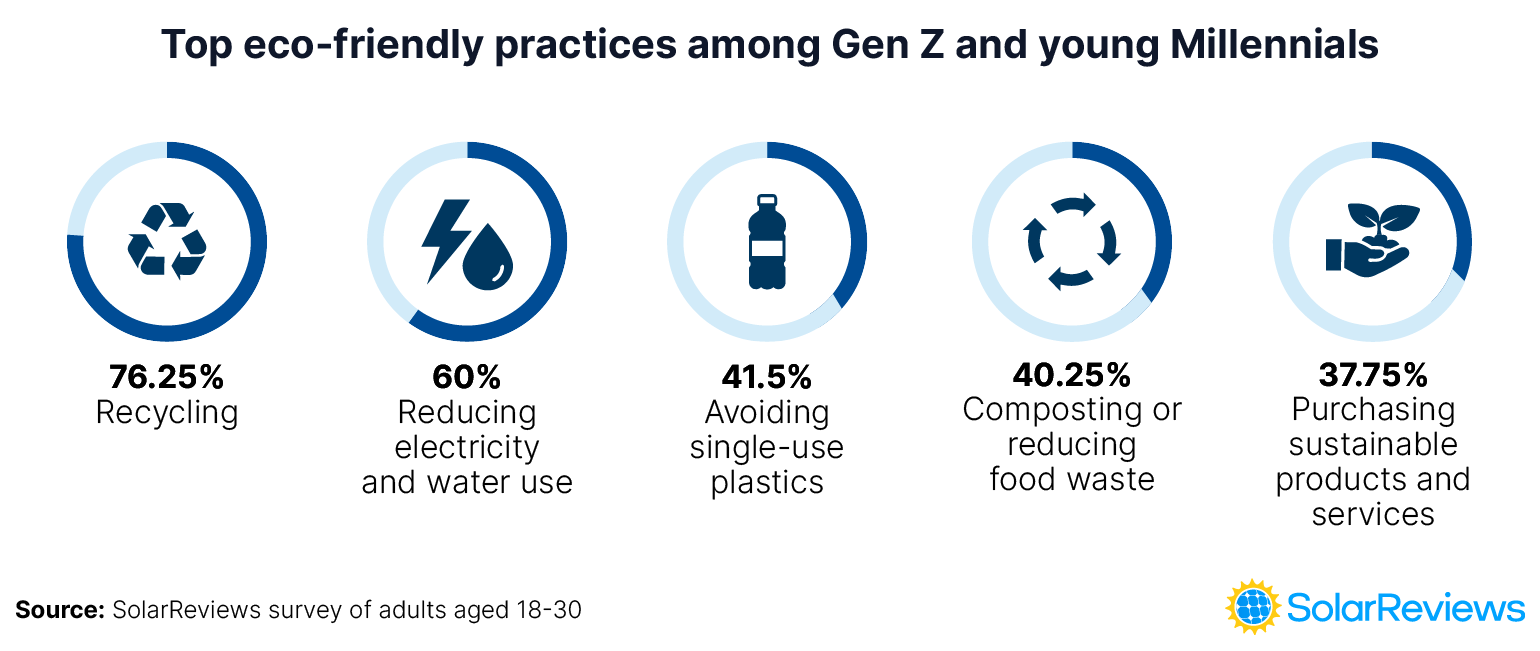
While it feels like almost everyone’s struggling to make ends meet, Gen Zers and young millennials are addressing climate change by seeking solutions that are low to no cost.
Respondents’ three most popular eco-friendly practices were recycling, reducing electricity and water usage, and avoiding single-use plastics. Owning an electric vehicle (6.25%) and utilizing solar power (12%) were among some of the least popular eco-friendly lifestyle choices, suggesting that respondents aren’t as quick to adopt costlier sustainable practices.
4. Over 75% of young millennials and Gen Z are interested in solar, but the cost is a significant barrier
In the survey, over 75% of respondents expressed interest in installing solar panels – if money was no object. Of that data, over 50% reported extreme interest.
However, our data also showed that 35% of respondents are only willing to pay up to $1,000 for an entire solar panel installation, and a majority of responses indicated they are only willing to pay $10,000 or less. This is much lower than the average cost of a solar panel installation, which sits at about $19,000 before incentives.
It isn’t surprising that younger generations aren’t willing to pay for solar panels when many feel they won’t even be able to purchase a home. But, even respondents who already own homes aren’t keen on shelling out tens of thousands of dollars — 58% of respondents who are homeowners said they wouldn’t spend more than $5,000 on solar.
Solar financing could serve as a glimmer of hope. According to a study by LendingTree, Gen Zers have the lowest amount of non-mortgage debt compared to any other current generation and are also less likely to owe student debt. Less debt could make a solar loan more feasible for this age group.
5. Individuals who recognize the true value of solar energy are more eager to invest
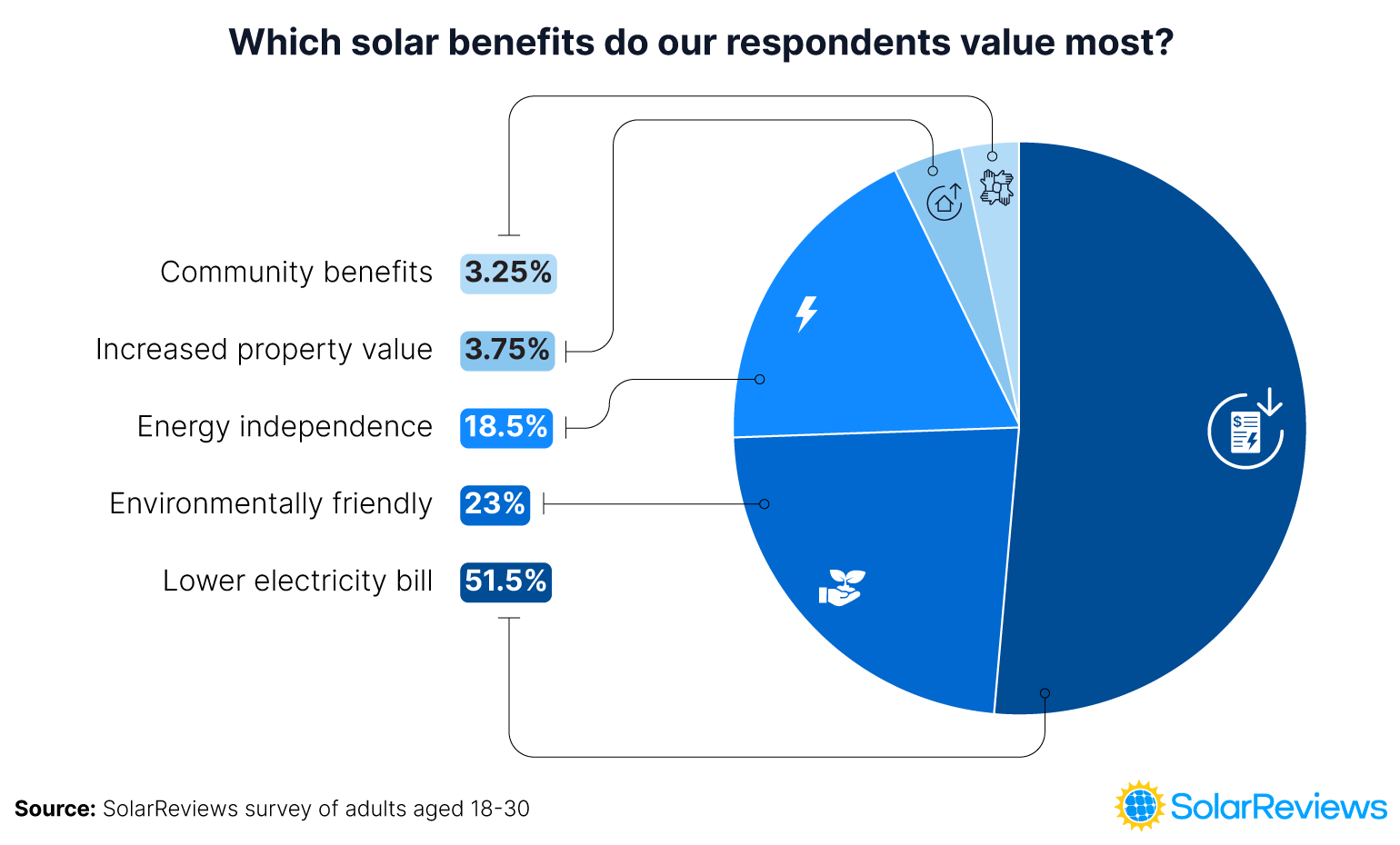
We asked Gen Zers and young millennials what they saw as the most significant benefits of going solar. Lower electricity bills took the top spot with 51.5% of the vote. Behind lower electricity bills, environmental benefits (23%) and energy independence (18.5%) were respondent favorites.
Looking at individual responses, we found correlations between those willing to spend more on a solar system and the appeal of some benefits. For starters, respondents willing to spend over $10,000 for a solar system had a 20% higher electricity bill on average. These respondents were also three times more likely to choose increased property value as an attractive benefit of solar panels.
These trends suggest that once individuals grasp the financial advantages of going solar, they may be more willing to invest.
Solar could be the solution young generations need — but things need to change
Most of our survey respondents aren’t just willing to participate in practices that benefit the environment — they want to. Going solar is a way to kill two birds with one stone, lowering household expenses and reducing carbon footprints. However, the upfront cost of going solar is just too high for younger generations, especially as economic conditions worsen.
We don’t see a future where full solar installations cost under $1,000, but some things can be done to reduce solar costs and help ensure the industry’s longevity.
Solar permitting reform
Solar permitting and other soft costs must decrease to make solar more affordable. When you break down the costs of a solar panel installation, solar panels themselves only account for about 18% of what you’re paying. Soft costs, including permitting, make up a whopping 44% of solar installation costs.
Soft cost savings could be achieved through more standardized solar permitting standards, such as switching to online permitting through services like SolarAPP+. It is crucial that services like this become available to all jurisdictions.
Solar incentive programs
Solar incentives are arguably the best way to make solar more affordable to all homeowners. The issue is that these programs are federally or state-funded, which means that where you live has a lot of influence on how affordable it is to go solar.
Existing incentives need to improve. For example, tax credit incentives with a direct pay option can benefit homeowners who need the upfront cost lowered instead of waiting until they file taxes. Also, additional rebates for low-income homeowners should be more widely available, as this demographic could benefit from lower electricity bills.
Community solar expansion
According to Self.inc, 34% of Americans are renters. This means over a third of Americans have limited access to solar. Expanding community solar is a way to give non-homeowners access to the benefits of solar. This can not only be a huge step toward a more renewable future and help solar be more attainable to a broader demographic of Americans.
Solar-friendly policy
Solar-friendly policies promote the widespread adoption of solar, domestic manufacturing, support of renewables and electrification, and more. These policies can be at the federal, state, or municipal level.
Some states have better solar policies than others or more of a solar carve-out within their renewable portfolio standards (RPS). States with better standards are more likely to give incentives and other benefits to going solar to meet their goals. If more states adopted solar-friendly policies, you’d see more incentive handouts and more funding allocated to developing solar projects.
Bottom line: Are solar panels feasible for future generations?
There are many events taking place in the U.S. today that are seen as unsettling or stressful for future generations. From this survey, we can conclude that most of our respondents want to participate in practices that are beneficial to the environment and are doing their part in combating climate change – they’re just finding cheap ways to do it.
Although the future is uncertain, we must recognize the importance of solar incentives and solar-friendly policies to make this technology more accessible to all. More than anything, the costs surrounding solar must go down.
To do this, adopting solar initiatives within the United States must come to fruition. The future of the solar industry will heavily rely on taking action. Solar should not become the next thing out of reach for upcoming generations, especially at a time when they might need it the most.
Jamie is a Content Writer and researcher at SolarReviews. A recent graduate of La Salle University in Philadelphia, Jamie earned her B.S. in communications with a concentration in journalism, mass media, and public relations. Jamie has previously worked at a marketing company where she had the opportunity to highlight and promote small business owners through long-form stories and interviews. With a deep-rooted passion for creativity, Jamie stri...
Learn more about Jamie Smith